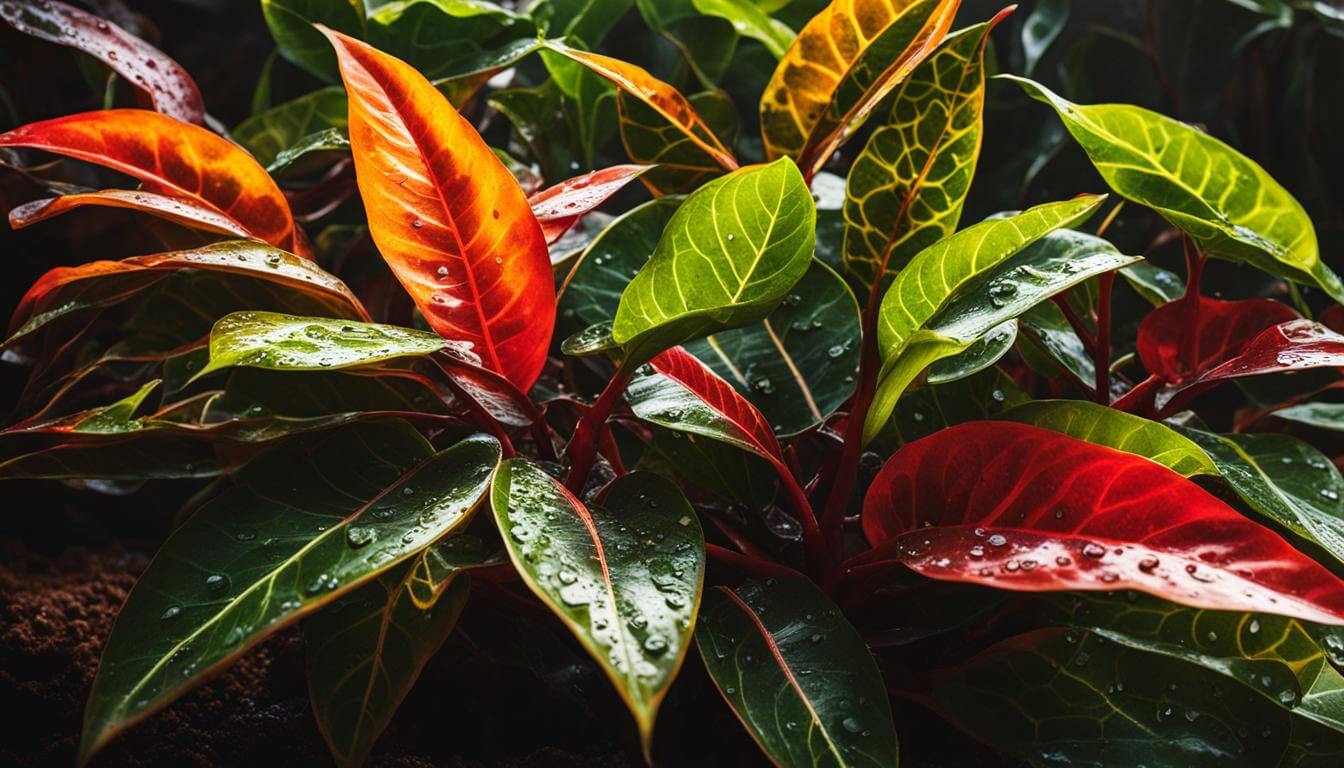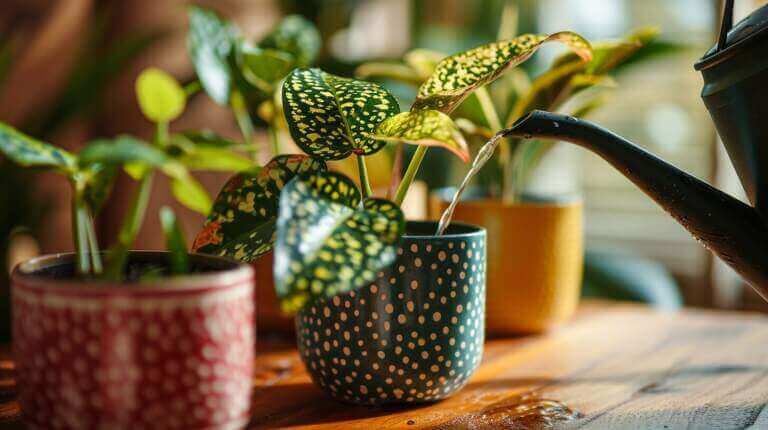When it comes to caring for croton plants, understanding their specific needs is crucial to ensure their vibrant and colorful foliage remains stunning. These tropical plants, scientifically known as Codiaeum variegatum, thrive in the right conditions. In this article, I will guide you through the key elements of croton plant care, including their light, water, soil, and humidity requirements.
Key Takeaways:
- Croton plants thrive in bright light conditions, requiring at least five hours of direct sunlight per day.
- Proper watering is crucial for croton plants, ensuring the soil is slightly moist but not overly wet.
- Well-draining soil that retains some moisture is ideal for croton plants, which prefer a slightly acidic pH level.
- Croton plants thrive in high humidity environments and require around 60% humidity.
- Regular fertilization during the active growth seasons can provide essential nutrients for croton plants.
By providing the right light, water, soil, and humidity conditions, you can create an optimal environment for your croton plants to thrive and maintain their stunning appearance. Let’s dive deeper into each of these aspects of croton plant care.
Light Requirements for Croton Plants
When it comes to caring for croton plants, providing the right amount of light is essential for their growth and vibrant foliage. These indoor plants thrive in bright light conditions, making them perfect for well-lit areas in your home. Croton plants require at least five hours of direct sunlight per day to promote healthy leaf development and maintain their colorful appearance.
If you don’t have a spot near a window that receives direct sunlight, don’t worry! Croton plants can also tolerate indirect light. Simply place them in a bright location where they can still receive a good amount of light. Just remember that insufficient light can result in poor leaf growth and dull colors, so it’s important to provide adequate light for your croton plants.
To summarize, croton plants have the following light requirements:
- Prefer at least five hours of direct sunlight per day
- Tolerate indirect light in well-lit areas
- Inadequate light can lead to poor leaf growth and lackluster colors
Now that you understand the light requirements for croton plants, you can ensure that they receive the right amount of light to thrive and showcase their beautiful, colorful leaves in your home.
Watering Guidelines for Croton Plants
Croton plants require proper watering to ensure their health and vitality. Understanding the guidelines for watering these plants is essential in preventing issues such as over-watering, under-watering, wilting, and drooping leaves.
Importance of Soil Moisture
The moisture level in the soil is a crucial factor to consider when watering croton plants. These tropical plants prefer slightly moist soil, but it is important not to over-water them. Over-watering can lead to root rot and other problems, while under-watering can cause the leaves to wilt and droop.
To determine when to water your croton plant, regularly check the moisture level of the soil. Insert your finger into the soil up to an inch deep. If the soil feels dry at this depth, it’s time to water the plant.
Watering Frequency
The frequency of watering will depend on various factors such as the type of potting soil used, the amount of sunlight the plant receives, and the indoor humidity levels. As a general guideline, water your croton plant when the top inch of soil feels dry. Avoid watering the plant if the soil still feels moist.
It is important to note that croton plants may require more frequent watering during the warmer months or if they are placed in a particularly sunny spot. Monitor the soil moisture regularly to ensure the plant receives adequate hydration.
Table: Watering Guidelines for Croton Plants
| Signs of Over-watering | Signs of Under-watering | Watering Frequency |
|---|---|---|
| Yellowing or browning leaves | Wilting and drooping leaves | Water when the top inch of soil feels dry |
| Musty smell in the soil | Dry and brittle leaves | Adjust watering frequency based on environmental factors |
| Root rot | Leaf drop | Monitor soil moisture regularly |
By following these watering guidelines and monitoring the soil moisture, you can ensure that your croton plant receives the proper hydration it needs to thrive. Remember to also take into account the specific environmental conditions in your home or garden when determining the frequency of watering.
Soil Requirements for Croton Plants
Croton plants have specific soil requirements to ensure their optimal growth and health. The right type of soil will provide adequate drainage while retaining enough moisture for the plant’s needs. Here are the key soil requirements for croton plants:
- Well-Draining Soil: Croton plants thrive in soil that allows excess water to flow out freely. Well-draining soil prevents waterlogging, which can lead to root rot and other moisture-related issues. It is important to choose a potting mix that provides good drainage for your croton plants.
- Potting Mix: Using a high-quality potting mix is essential for croton plants. Look for a mix that is specifically formulated for indoor plants or tropical plants. These mixes often contain the right balance of organic matter, perlite, and other ingredients that provide adequate moisture retention and nutrient availability.
- Acidic Soil: Croton plants prefer slightly acidic soil with a pH level between 5.5 and 6.5. You can test the acidity of your soil using a pH testing kit available at garden centers or online. If your soil is too alkaline, you can adjust the pH level by adding organic matter such as peat moss or compost.
- Moisture Retention: While croton plants require well-draining soil, it is still important for the soil to retain some moisture to keep the plants hydrated. Adding organic matter or compost to the soil can help improve its moisture retention capacity.
Table: Comparison of Different Potting Mixes for Croton Plants
| Potting Mix | Drainage | Moisture Retention | Acidity (pH) |
|---|---|---|---|
| Standard Potting Mix | Good | Moderate | Neutral (6.5-7) |
| Tropical Potting Mix | Excellent | High | Slightly Acidic (5.5-6.5) |
| Cactus/Succulent Mix | Excellent | Low | Neutral (6.5-7) |
It is important to choose a potting mix that aligns with the specific soil requirements of croton plants. The right soil composition will provide optimal conditions for growth, development, and vibrant foliage. Remember to regularly monitor the moisture levels in the soil and adjust your watering routine accordingly to maintain a healthy balance for your croton plants.
Humidity Needs for Croton Plants
Croton plants are known for their love of high humidity, which mimics their native tropical environment. Adequate humidity levels are essential for the health and vitality of these stunning indoor plants. Maintaining the right humidity level in the air helps prevent issues such as dryness, leaf browning, and even pests.
To meet the humidity needs of your croton plants, aim for a humidity level of around 60%. One effective method is placing the plants on a tray filled with water and pebbles. As the water evaporates, it increases the moisture in the surrounding air. Additionally, using a humidifier in the room can help create the ideal humidity level for your crotons.
Methods for Increasing Humidity
1. Tray with water and pebbles: Fill a shallow tray with water and place pebbles in it. Set the potted croton plant on top of the pebbles, ensuring that the water level does not touch the bottom of the pot. As the water evaporates, it creates moisture in the air.
2. Humidifier: Purchase a humidifier specifically designed for indoor use. Set it up near your croton plants to release a fine mist of water vapor into the air, increasing the humidity level in the room.
Remember that misting the leaves of croton plants only provides temporary relief and does not significantly impact the humidity levels. It is important to maintain consistent moisture in the air to keep your croton plants healthy and vibrant.
| Humidity Level | Recommended Method |
|---|---|
| Below 40% | Use a humidifier to increase humidity levels in the room. |
| 40% – 60% | Regular misting of leaves and placement on a tray with water and pebbles can help maintain humidity. |
| Above 60% | Monitor humidity levels to prevent excess moisture, as this can lead to fungal diseases. |
Fertilizing Croton Plants
Fertilizing croton plants is an essential part of their care routine to provide them with the necessary nutrients for healthy growth and vibrant foliage. Proper plant nutrition ensures that crotons maintain their stunning colors and thrive in indoor settings. Understanding the right type of fertilizer, feeding schedule, and growth season is crucial for successfully fertilizing croton plants.
Plant Nutrition and Liquid Fertilizer
Croton plants require a balanced supply of macronutrients and micronutrients to support their growth. A liquid fertilizer diluted to half strength is often recommended for croton plants, as it allows for better absorption by their root systems. The liquid form of fertilizer also provides a more immediate nutrient boost compared to slow-release granules or pellets.
Feeding Schedule and Growth Season
It is important to establish a feeding schedule for your croton plants to ensure consistent nutrient supply. During the active growth seasons, typically in spring and summer, it is recommended to feed crotons monthly. This helps support their increased growth rate and higher nutrient demand during these periods.
However, it is crucial to adjust the feeding schedule based on the specific needs of your croton plants. Monitoring their growth rate can help determine whether they require more or less frequent fertilization. It is important to note that croton plants are dormant during winter months, so it is best to stop fertilizing during this time to avoid nutrient build-up in the soil.
| Fertilizing Croton Plants: Key Points |
|---|
| Croton plants require balanced macronutrients and micronutrients. |
| Use a liquid fertilizer diluted to half strength for better absorption. |
| Establish a feeding schedule, typically monthly during active growth seasons. |
| Adjust the feeding schedule based on the specific needs of your plants. |
| Avoid fertilizing croton plants during winter when they are dormant. |
By following proper fertilization practices, you can ensure the optimal health and vitality of your croton plants while enjoying their vibrant foliage year-round. Remember to always read and follow the instructions on the fertilizer label for best results.
Common Issues and Troubleshooting for Croton Plants
While croton plants are generally resilient, they can still encounter common issues that can affect their health and appearance. It’s important to be aware of these problems and take appropriate measures to troubleshoot and resolve them. Here are some common issues to watch out for when caring for your croton plants:
Pest Infestations:
Croton plants are susceptible to various pests, including spider mites, scales, and mealybugs. These pests can damage the leaves, sap nutrients from the plant, and even cause wilting. Regularly inspect your croton plants for signs of pests, such as webbing, small insects, or sticky residue on the leaves. If you notice an infestation, treat it promptly with insecticidal soap or neem oil, following the product instructions carefully to ensure effectiveness.
Root Rot:
Over-watering can lead to root rot in croton plants. When the soil becomes waterlogged, it deprives the roots of oxygen, leading to their decay. Signs of root rot include wilting leaves, yellowing or browning of foliage, and a foul odor coming from the soil. To prevent root rot, make sure your croton plants are potted in well-draining soil and do not let them sit in standing water. Adjust your watering routine to allow the top inch of soil to partially dry out before watering again.
Wilting Leaves and General Decline:
Wilting leaves can be caused by various factors, including under-watering, temperature stress, or insufficient light. If your croton plants’ leaves are drooping and losing their vibrant colors, assess their care conditions. Ensure that they are receiving adequate water, moderate temperatures (between 60°F and 70°F), and enough bright, indirect light. Adjusting these factors to meet the plant’s needs can help revive drooping leaves and prevent further decline.
| Issue | Symptoms | Solution |
|---|---|---|
| Pest Infestations | Webbing, small insects, sticky residue on leaves | Treat with insecticidal soap or neem oil |
| Root Rot | Wilting leaves, yellowing/browning foliage, foul odor from soil | Ensure well-draining soil, avoid over-watering |
| Wilting Leaves and General Decline | Drooping leaves, loss of vibrant colors | Assess water, temperature, and light conditions |
Pruning and Propagation of Croton Plants
Pruning and propagation are essential aspects of plant maintenance for croton plants. Proper pruning can promote new growth, shape the plant, and maintain its overall density. To prune your croton, start by removing any dead or dying leaves during the spring season. Trimming back excessive growth will help maintain the plant’s compact shape and ensure its health.
In addition to pruning, croton plants can also be propagated through stem cuttings or division. Stem cuttings involve taking a 4- to 6-inch stem with at least three leaves and planting it in moist potting soil. This method allows the cutting to develop roots and grow into a new plant. Another option is water propagation, where the cutting is placed in water until roots form and then transferred to potting soil.
Both pruning and propagation should be approached with care. It is recommended to wear gloves when handling croton plants as their sap can cause skin irritation. By practicing regular pruning and exploring propagation methods, you can effectively maintain and multiply your beautiful croton plant collection.
FAQ
What are croton plants?
Croton plants, scientifically known as Codiaeum variegatum, are tropical plants with vibrant and colorful foliage.
What are the light requirements for croton plants?
Croton plants thrive in bright light conditions and require at least five hours of direct sunlight per day. They can also tolerate indirect light if a bright spot near a window is not available.
How should I water my croton plants?
Croton plants prefer to be slightly moist but not overly wet. It is important to let the soil partially dry out between waterings to prevent over-watering. Water when the top inch of soil feels dry.
What kind of soil do croton plants prefer?
Croton plants thrive in well-draining soil that allows water to flow freely. They prefer slightly acidic soil with a pH level between 5.5 and 6.5.
How do I maintain the humidity levels for croton plants?
Croton plants prefer high humidity environments. You can achieve this by placing the plants on a tray filled with water and pebbles or using a humidifier.
How often should I fertilize my croton plants?
It is recommended to use a complete liquid fertilizer diluted to half strength and feed the plants monthly during the active growth seasons, which are typically spring and summer.
What are common issues I may encounter with croton plants?
Common issues include pest infestations, such as spider mites, scales, and mealybugs, as well as root rot from over-watering. Wilting or drooping leaves may indicate various issues, including under-watering, temperature stress, or insufficient light.
How should I prune and propagate my croton plants?
Pruning can be done during the spring season by removing dead or dying leaves and trimming excessive growth. Crotons can be propagated through stem cuttings or water propagation.







